Pro PR tips on how to pitch to journalists
Press members hold the power to accept and publish your stories. Here are a few data-driven insights on how to pitch to journalists.

PR continues to be one of the most important factors when building a brand’s reputation and visibility in the public eye. However, it’s a tricky game, as the published content is ultimately out of the marketer’s hands and under the journalist’s control. Journalists can take a press release and use it to write any story they see fit.
This is why public relations is not just about storytelling, but also about understanding how to pitch to journalists.
Those who seek insights about how to get on a journalist’s good side can get some answers from Cision’s 2021 State of the Media and Muck Rack’s The State of Journalism 2021 reports.
Here are a few fresh data points to help guide your PR strategy.
What kind of stories are journalists looking for?
This is important ground to cover, especially as most journalists receive more than 50 pitches a week. 69% of journalists believe that three out of four pitches they receive are irrelevant.
See: For beginners: 6 tips on how to write a press release (with examples)
61% of journalists recommend PR pros do their homework before sending the pitches. PR practitioners should understand each journalist’s target audience and what kind of stories are relevant to them.
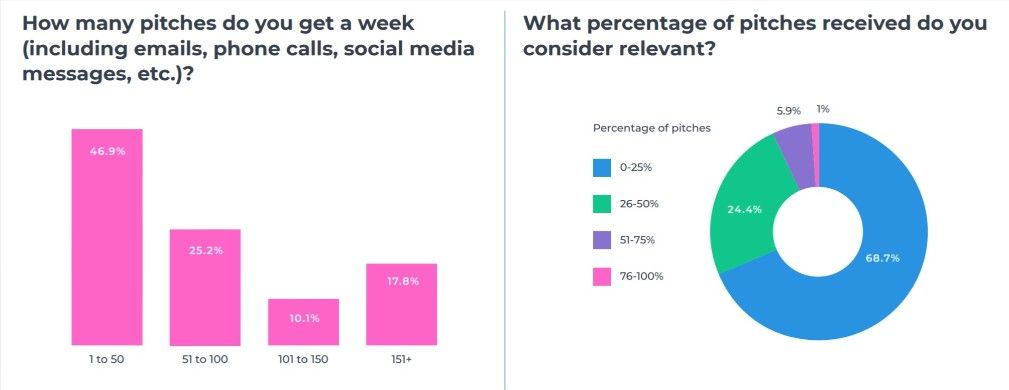
Sending irrelevant pitches is not just time-wasting for both sides, it’s also risky. Journalists share that they tend to block emails they consider too spammy.
“I don’t expect every single pitch to be relevant, but if you have no idea of my beat, you’re just spamming me,” said one of the respondents.
Fortunately, journalists also gave input about their story preferences this year.
In a year of a pandemic, journalists are hungry for positive and “feel good” stories. These can include stories about how companies and communities are helping others (36.5%), stories on furthering diversity, inclusion, and equality (33.3%), and new technologies that are helping businesses and consumers (30.5%).
Journalists are also looking for new angles related to Covid-19 (45.5%), and stories about how companies and communities are getting back to normal (32.3%). Research-based, thought leadership content is also good PR fuel for journalists (29.4%).
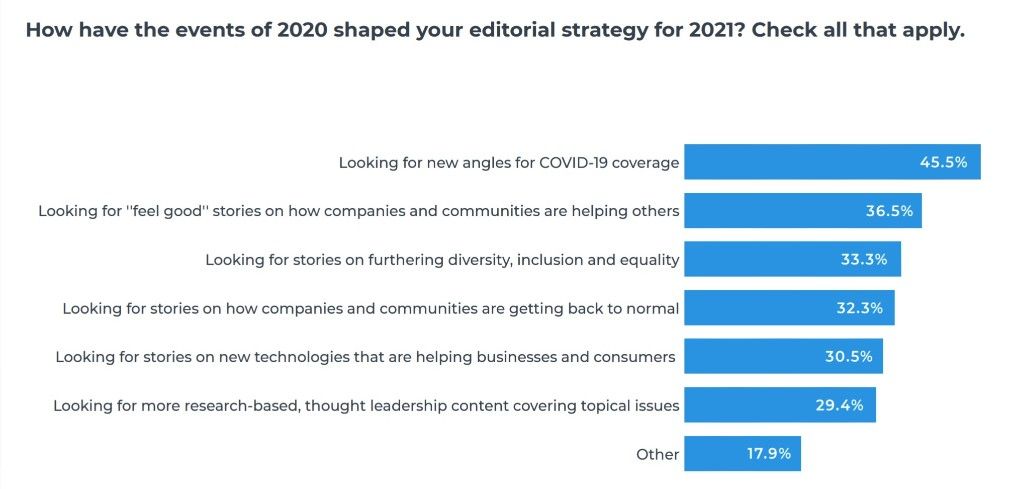
Some topic ideas that journalists shared revolve around how businesses are pivoting to serve customers post Covid-19, sustainable business and ESG (environment, social, and governance) investing, and stories related to racial and social justice.
PR pros also stand a better chance of getting their pitch noticed when they can cover subjects related to a particular trending topic (78%), or offer surprising data (59%).
See: 6 recommended press release distribution services for PR teams
What are the best pitch formats to send to journalists?
In general, PR practitioners should keep their story pitches short and sweet. The vast majority of journalists (91%) prefer to receive pitches under 200 words. One in three prefer to receive quick, snappy pitches with clear facts that enable them to produce short-form content quickly.
78% of journalists want to receive news announcements and press releases from brands and organizations. Their other favorite pitch formats are original research (67.5%), invitations to events (44.7%), and initial ideas for story development (43.3%).
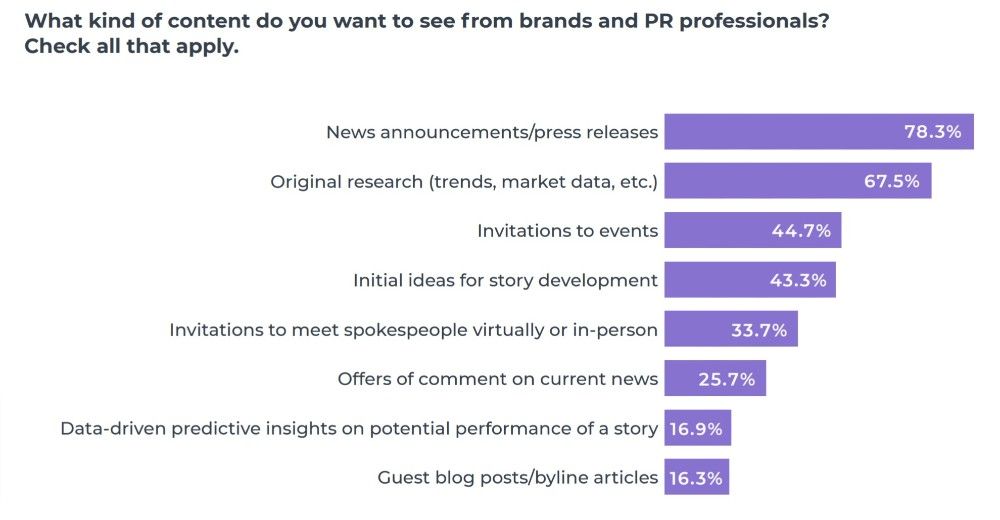
PR pros should also note that fewer than one in five journalists look for guest posts. This means the most effective way to approach journalists is by sending story pitches, and not inquiring about guest publishing.
As a warm reminder, journalists love multimedia assets when included with the press release. Four out of five journalists always include images in their articles, while almost half of them also include videos and infographics. Interestingly, 39% of journalists also embed social media posts in their content.
What is the best way to send pitches to journalists?
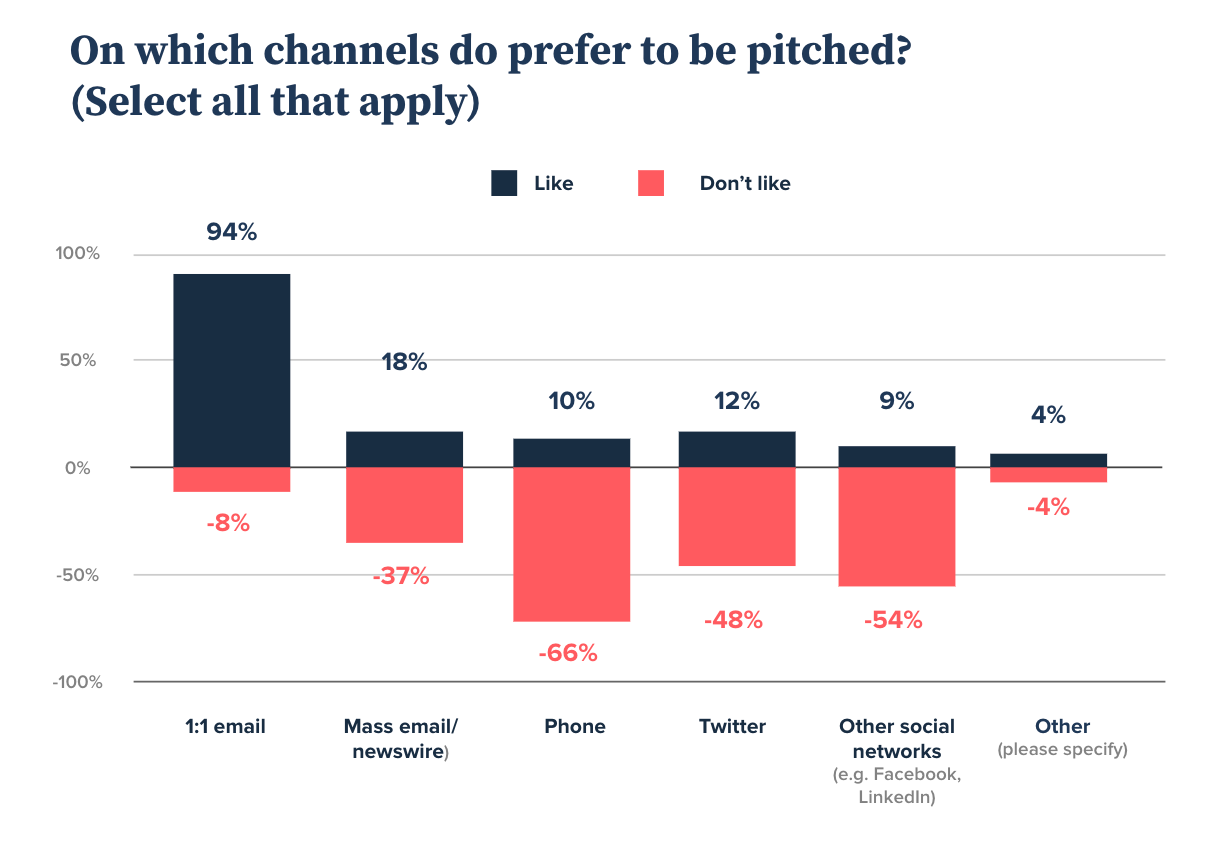
94% of journalists prefer to receive pitches via one-on-one email. Both studies also indicate that journalists prefer to get pitches on Monday or Tuesday, between 8 am and 12 pm.
72% of journalists expect to receive follow-ups from organizations. Most of them prefer to get at least two days of breathing room before getting that follow-up.
If you want to get on the journalist’s bad side, the worst way to contact them is via phone (66% dislike it) on Saturday or Sunday, after 4 pm. We don’t recommend this.
As a quick side note, one respondent advised PR pros to send a single email when approaching different people who work at the same news outlet.
See: 5 lesser-known places to hire freelance press release writers
What are the things to avoid when pitching to journalists?
Journalists are very busy. Almost half of them (47%) cover five or more beats. To keep their workflow manageable, they regularly put people on the blocklist to reduce distractions. Here are some things that PR pros should avoid.
First, sending too many spammy pitches (73%). As mentioned earlier, any pitch that’s not relevant to a journalist’s beat and audience will likely be considered spam. Sending press releases that sound too much like a marketing brochure is also bad.
On the other hand, journalists view PR pros that consistently send relevant pitches more positively in the long run.
Second, sending too many follow-ups (51.7%). To stay safe, limit the follow-ups to just one or two. If there’s still no response, it means the journalist simply isn’t prioritizing your story. Don’t hassle them further.
Third, providing inaccurate or unsourced information (51.3%). Double or triple check all your data before pressing that send button.
Other things to avoid include dodging inquiries/lack of transparency (46.1%), failure to respond before the deadline (29%), broken embargoes (23.5%), and last-minute cancellations (23.5%).
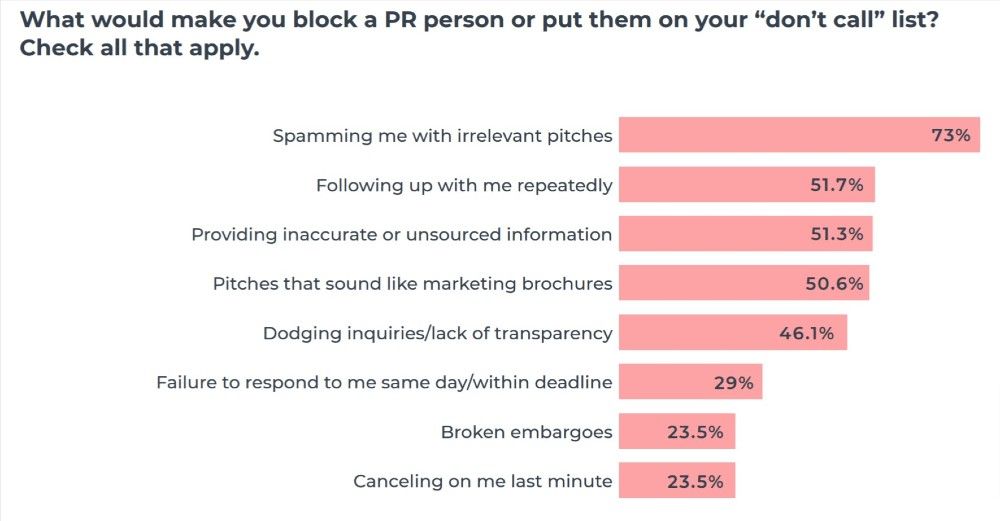
It is worth noting that journalists regularly look for credible story sources, and they are happy when PR pros can help them in this regard (65.5%). One in five says that they would like to have the PR person’s phone number in case they need quick information.
See: 5 lesser-known places to hire freelance press release writers
Save time and money when producing and distributing high-quality press releases. ContentGrow helps marketing teams create and distribute content at scale, directly sourced from project-appropriate writers and journalists at preferred rates. Fill out the form below to distribute your press release in APAC and beyond.


